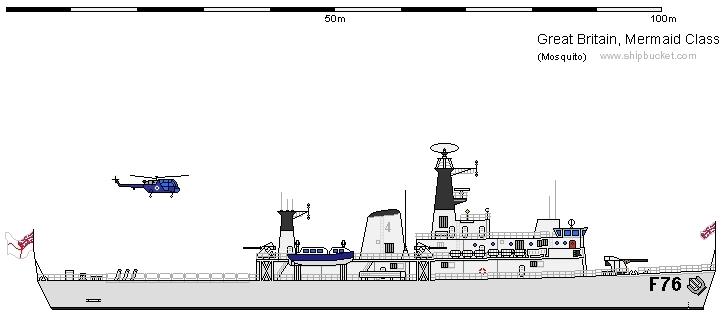|
|
|
|
HOME
|
US Navy -
ships
|
US Navy - air
units
|
USMC - air
units
|
International
Navies
|
Weapon Systems
|
Special Reports |
|
|
|
|
|
|
|
Royal Navy - FrigateF 76 HMS Mermaid |
|
|
|
|
| sorry, no insignia |
 |
|
|
|
|
Type,
class: Mermaid class Frigate (unique unit) Builder: Yarrow Shipbuilders, Scotstoun, U.K. STATUS: Awarded: - Laid down: ? originally built for Ghana as Black Star order cancelled in 1966 Launched: December 29, 1966 renamed HMS Mermaid (F 76) Commissioned: May 16, 1973 Decommissioned: ? transferred to Royal Malaysian Navy in 1977 renamed KD Hang Tuah (F 76) Technical Data: Length: 103,5 meters (339 ft 7 in) Beam: 12,2 meters (40 ft) Draft: 4,9 meters (16 ft 1 in) Displacement: 2340 tons (standard) Speed: 24 knots (44 km/h) Range: - Complement: 210 Propulsion: 8 x 16-cylinder diesel engines (14400 shp) 2 shafts / 2 propellers Armament: 1 x Bofors 57mm gun 2 x Bofors 40mm guns Aviation: aft helicopter platform |
|
|
|
|
ship images |
|
|
sorry, no photos |
|
|
|
|
|
HMS Mermaid (F 76): HMS Mermaid was a singleton vessel, originally built for Ghana. It was to have been named the Black Star and to have functioned as the flagship of Ghana's navy as well as the presidential yacht for Kwame Nkrumah. After Nkrumah was ousted in 1966, the new government cancelled the order due to the excessive cost (around GBP 5 million at that time, equivalent to £83,183,000 today). As the vessel was not completely finished, it was kept at anchor for several years and eventually transferred from the Firth of Clyde to Portsmouth Dockyard in April 1972 and then to Chatham Dockyard to be refitted to bring her up to Royal Navy standards. Design: The basic design of the ship was based on the Royal Navy Type 41/Type 61 hull and machinery, but modified to suit the requirements of the Ghana Navy. The hull was flush decked, and the exhausts streamlined into a single funnel. There were extra accommodation areas in the superstructure and the armament was kept relatively simple to keep the cost down. Mounted forward of the bridge was a Mark 19 mounting with twin 4 inch guns, there were four single Bofors 40 mm guns around the upper superstructure, and a Squid A/S mortar mounted aft. Sonar Types 170 and 176 were carried as was a Plessey AWS-1 radar on the foremast and a navigational radar forward of this on a platform. The ship had a displacement of 2,300 tons as standard, had a maximum speed of 24 knots and a complement of 177 officers and men in Royal Navy service. Royal Navy service: She was finally commissioned on 16 May 1973 into the Royal Navy as HMS Mermaid with a pennant number of F76 and after working up, was dispatched to the Far East where she was based at Singapore. Her light armament and minimal sensor fittings made her unsuitable for a role in the European environment but could provide a useful presence in the Far East, undertaking what is now known as 'defence diplomacy' roles. She stood in for HMS Chichester (the guardship for Hong Kong) at times and stood by at the end of the Vietnam War in case British nationals had to be evacuated from Saigon. Upon returning home she was involved in an unfortunate collision with the minesweeper HMS Fittleton during a NATO exercise that resulted in the Fittleton's sinking and the deaths of a number of the RNR crew. The Mermaid was used to protect UK trawlers during one of the Cod Wars with Iceland in the 1970s over fishing rights. The frigate and the Icelandic gunboat Baldur came into close contact on the high seas. After being paid off she helped to conduct trials on a moving target indicator system that helped radar to pick out targets moving against the clutter generated by the surface of the sea. Royal Malaysian Navy service: In April 1977 she was transferred to the Royal Malaysian Navy and replaced Hang Tuah, the ex-Loch-class frigate HMS Loch Insh. Although Mermaid took her predecessor's name, the Malaysian Navy retained the British pennant number F76. For a number of years she served as the flagship of the Royal Malaysian Navy after joining Rahmat as the two major assets of the Royal Malaysian Navy. Hang Tuah became a training ship in 1992. Between 1995 and 1997, the ship was subject to a major refit, with two new diesel engines being fitted, with a power of 9,928 brake horsepower (7,403 kW) giving a speed of 20 knots (37 km/h), the obsolete 4 inch guns being replaced by a Bofors 57 mm gun, and the Limbo anti-submarine mortar and sonars being removed. Presently Hang Tuah is serving as a training ship and is assigned to Frigate Squadron 21. The Commanding Officer is Captain Zualkafly bin Haji Ahmad, TLDM. source: wikipedia |
|
|
|
|
|
|
|
|
patches |
|
|
|
|
|
|
seaforces.org
|
Royal
Navy start page
| |
|
